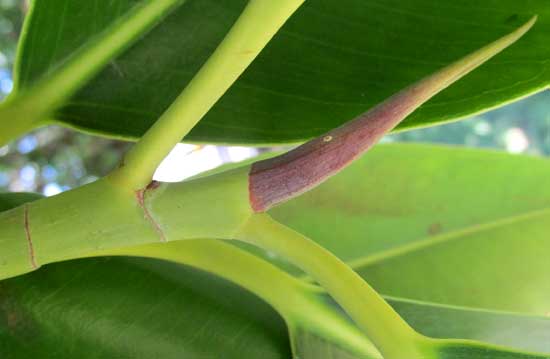Excerpts from Jim Conrad's
Naturalist Newsletter
from the May 15, 2016 Newsletter issued from Hacienda Chichen Resort beside Chichén Itzá Ruins; limestone bedrock; elevation ~39m (~128ft), N20.675°, W88.569°; central Yucatán state, MÉXICO
FICUS ELASTICA
Last week I accompanied some guests to Valladolid about 45 minutes east of the Hacienda, where we visited the historic Convent of San Bernardino. At the edge of the plaza in front of the convent a fair-sized tree bore many woody, rootlike growths dangling from its limbs. These aerial roots had been cut so people could walk beneath the tree. Below, you can see what this looked like:

The tree was clearly a kind of strangler or banyan fig -- a fig tree whose seeds often germinate on branches of other trees, the resulting fig plant grows as an epiphyte on its host tree while sending adventitious roots toward the ground as it grows upward, where eventually it overtops the host tree. Below, as its roots enclose the host tree's trunk, with time it "strangles" or "out-competes" the host for resources, killing the host, leaving the fig standing in its place, becoming a regular, respectable-looking tree, like the one in the picture.
Humid American tropical forests are full of fig species with vegetative parts so similar that usually if the trees aren't fruiting I don't even try to figure out their species. The tree in our photo wasn't fruiting, but when I looked at the leaves, I figured I knew which species it was without even "doing the botany." Below, you may recognize it yourself:

A closer look at its thick stem and long, pinkish terminal bud is shown below:

You, like me, may have coexisted with several individuals of this species doing houseplant duty up north, for cut stems of this species easily root and grow, and the resulting potted plants tolerate shade and drought, and can grow in almost any type of soil as long as it's well-drained. Its weakness is strong winds, for it tends to break apart during storms.
This is FICUS ELASTICA, often called Rubber Plant, though one must avoid calling it the Rubber Tree, because that name is more properly claimed by other species. Still, such copious amounts of milky latex pours from the species' wounds that in the past it has been used for making rubber. Often its binomial name is used as a common name, people just calling it Ficus Elastica.
Ficus Elastica is native to southeastern Asia, but it's been introduced in much of the world's tropics and semi-tropics, where it's "gone wild," including in Florida. In fact, Randall's 2014 "Global Compendium of Weeds characterizes it as an "environmental weed, garden thug, naturalised, weed." A while back some guests from southern California told me that in their area strangler figs are outlawed because their roots cause sidewalks and pavement to buckle.
Ficus Elastica's weediness is mitigated by the fact that, like other figs, its reproduction requires a specific wasp pollinator species, and in most places where the plant has appeared its pollinating wasp species has not, so Ficus Elastica can't reproduce by seeds in these places.
I can't find information about whether the wasp pollinator for Ficus Elastica has been introduced into Mexico, so I assume that the tree in our pictures was planted by someone.
Whatever its history, on that hot afternoon last week, the tree provided delicious shade, and a nice bouquet of dark greenness at the edge of a sizzling open area, and I don't begrudge anyone who might have planted it there.